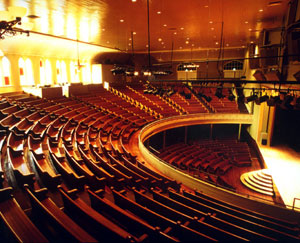
Ryman Auditorium
Built as the Union Gospel Tabernacle between 1888 and 1892, Nashville’s Ryman Auditorium gained international renown from 1943 to 1974 as home to the Grand Ole Opry, the premier live country music radio broadcast of Nashville station WSM. It is recognized as the “mother church” of modern country music. With the powerful WSM signal, the Grand Ole Opry reached millions of households in the United States and Canada. It made the music careers of many country music stars, and membership in the Opry remains a coveted honor.
Funding for the construction of the estimated one-hundred-thousand-dollar original tabernacle came largely from the tireless efforts of Reverend Sam Jones and the generosity of steamboat captain and businessman Tom Ryman. Designed by local Nashville architect Hugh Thompson in a dignified Victorian Gothic style, the building is distinguished by its steeply gabled roof, gable-front entrance, and tall Gothic lancet windows. In 1897 the seating capacity was expanded when the Confederate Veterans Association donated funds to construct a balcony, which has since been known as the Confederate Gallery. Other citizen groups raised money in 1901 and 1904 so that the stage could be enlarged for Grand Opera productions from the Metropolitan Opera of New York City and the French Grand Opera Company of New Orleans. After Ryman’s death in 1904, Jones proposed that the building’s name be changed to honor Ryman and from that point on, the building was known as Ryman Auditorium.
Throughout the years, the Ryman has hosted lectures, classical concerts, popular music performances, conventions, and dramatic plays. Speakers have included the populist leader William Jennings Bryan and African American leader Booker T. Washington, while performers have ranged from Enrico Caruso to Bob Hope to Sarah Bernhardt. After the construction of the War Memorial Building in the mid-1920s, many classical music performances and plays moved to that new venue. But the Ryman regained its position as the city’s focal point for live performances when the Grand Ole Opry moved its weekly broadcasts to the building in 1943. It was the center of a lively music and honky-tonk scene that centered along adjacent Broadway and spawned such local institutions as Tootsie’s Orchid Lounge and Ernest Tubb’s Record Shop.
In 1974 the owners of the Grand Ole Opry left the Ryman for new quarters at the Opryland complex. Once threatened with demolition, the building was saved, but it slowly deteriorated as it was used only for tours and for occasional concerts, television tapings, videos, and movies. In 1988-90 the owners stabilized the building, and in 1993 Gaylord Entertainment commissioned Nashville architectural firm Hart Freeland Roberts to restore the Ryman to its former glory as a grand public assembly hall. With fifteen hundred seats available, the Ryman Auditorium schedules performances throughout the year. It was listed as a National Historic Landmark in 2001.



